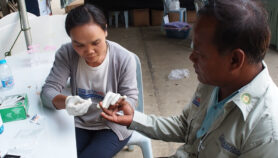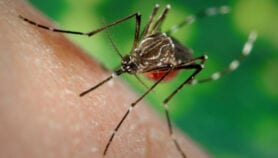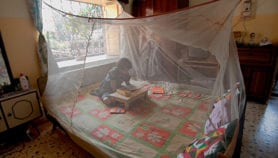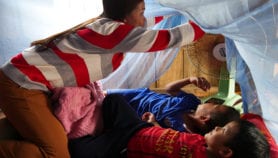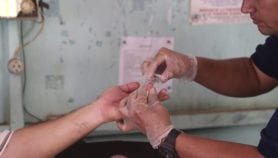25/04/19
Malaria meet focuses on elimination by 2030
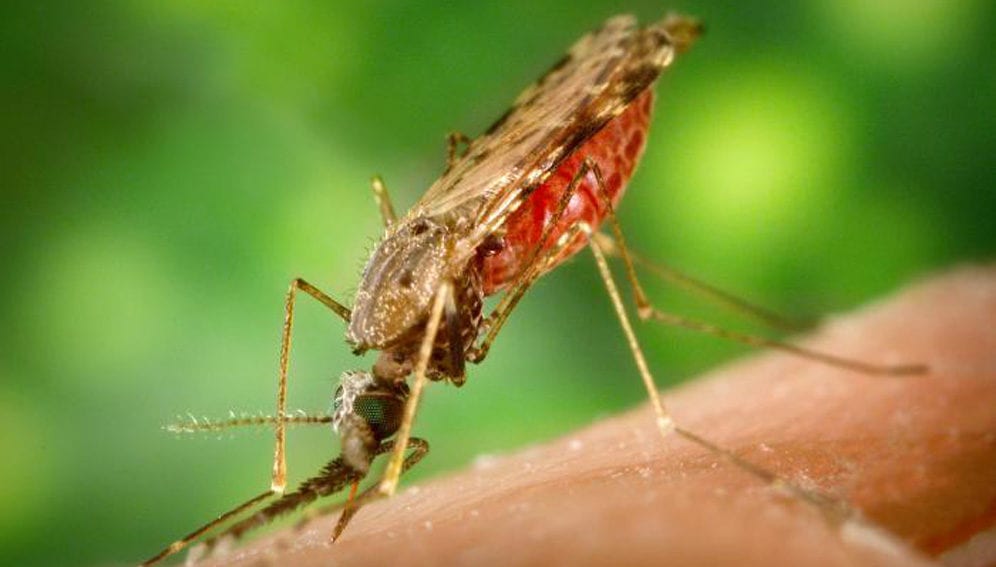
By: Sabine Dittrich, Yen Nguyen and Benjamin Rolfe
Send to a friend
The details you provide on this page will not be used to send unsolicited email, and will not be sold to a 3rd party. See privacy policy.
Asia Pacific malaria meet focuses on better diagnostics and other strategies to eliminate the disease by 2030.
As the Asia Pacific Leaders Malaria Alliance (APLMA) Senior Officials Meeting (SOM) (24 to 25 April) continues in Bangkok, we reflect on the opportunities and challenges in the region.
Leaders of the Asia Pacific region have committed to eliminating malaria by 2030. But to reach this goal, timely access to malaria commodities to test for the disease is vital.
Unclear registration processes and guidelines cause delays in access to new diagnostics such as next-generation rapid tests that are critical for the last mile of malaria elimination. Without access to improved diagnostics, we might miss opportunities to detect the disease in hard-to-diagnose populations. We might also have problems differentiating between parasite strains to inform treatment decisions.
Additionally, the World Health Organization (WHO) highlights the strength of national health systems and level of investment in malaria control as being particularly relevant. (1)
“While the malaria burden is decreasing with the region moving steadily towards elimination, progress made to date must be protected by ensuring that the last cases are found and treated so that transmission is interrupted early. The fact that not everyone with the disease exhibits symptoms makes it complicated.”
Benjamin Rolfe, Yen Nguyen and Sabine Dittrich
Progress towards malaria elimination in Asia Pacific has been remarkable. There has been a 47 per cent decrease in cases and 78 per cent decrease in deaths since 2010 across the 22 APLMA countries. (2) The APLMA countries are: Afghanistan, Bangladesh, Bhutan, Cambodia, China, DPR Korea, India, Indonesia, Lao PDR, Malaysia, Myanmar, Nepal, Pakistan, Papua New Guinea, the Philippines, Republic of Korea, Solomon Islands, Sri Lanka, Thailand, Timor-Leste, Vanuatu and Vietnam.
However, rate of progress varies from country to country due to the heterogeneity of malaria in the region and differences in capacity to drive a response across all provinces. Malaria continues to be predominantly a disease of the rural poor and those living or working in remote or forested areas.
Critical challenges such as the rising threat of drug resistance in the Greater Mekong Subregion (GMS) could hinder the progress made. Given that nearly 237 million people in the region remain at high risk, the impact of a disease which results in morbidity and often mortality within rural communities is profound, both socially and economically.
While the malaria burden is decreasing (2) with the region moving steadily towards elimination, progress made to date must be protected by ensuring that the last cases are found and treated so that transmission is interrupted early. The fact that not everyone with the disease exhibits symptoms makes it complicated.
Diagnostics are central to elimination efforts: for case finding, to ensure that both symptomatic and asymptomatic patients are identified and can be treated in order to break the chain of transmission; and for surveillance, to track disease spread and eventually confirm elimination.
In addition, diagnostics are crucial to determine which species of malaria parasite is responsible for the infection as different species need different treatment strategies. Plasmodium vivax, a relapsing strain of malaria, is responsible for over a third of malaria infections in South-East Asia. (2) While the incidence of Plasmodium falciparum malaria is falling, the relative burden of P. vivax is increasing in the GMS. In 2018, more than 60 per cent of the cases were P. vivax or a dual infection with both P. vivax and P. falciparum. (3)
In many settings, light microscopy is still a standard method for diagnosing malaria. (4) However, it relies on highly-trained technicians and laboratories that are generally few and far between, particularly in rural settings. Rapid diagnostic tests (RDTs), which can be administered in the community, are essential for last-mile diagnosis, but only a few of the currently available RDTs can effectively detect P. vivax infection.
Technical challenges include the low expression levels of the marker used to detect P. vivax and the low-parasite densities in the blood typically seen in asymptomatic cases. There is currently no diagnostic test that can effectively detect inactive parasites lying in wait in the liver.
Fortunately, there is a strong pipeline of new tools for both P. falciparum and P. vivax testing which includes cutting-edge technologies at varying levels of development. Abbott, PATH and FIND are working with the support of the Bill & Melinda Gates Foundation on improved RDTs with better sensitivity to both P. vivax and P. falciparum.
PATH’s DIAMETER (Diagnostics for Malaria Elimination Toward Eradication) project is developing improved malaria detection technologies such as enhanced microscopy systems. (5) FIND is also collaborating with multiple academic groups to explore the development of a simple RDT that can detect P. vivax parasites hiding in the liver, so latent infection can be tackled even before patients fall ill.
This work is being conducted in the context of FIND’s integrated malaria and fever strategy. (6) The strategy recognises that elimination depends on diagnosing (and treating) every last infection to prevent resurgence. Incorporating malaria testing into diagnostics for any patient presenting with fever is one way to achieve this.
Tafenoquine, a recently approved radical cure for P. vivax malaria, is exciting news for the community, but it should be used carefully. While taking this medicine, patients with a confirmed deficiency of the metabolic enzyme glucose-6-phosphate dehydrogenase (G6PD) are at increased risk of haemolysis, a serious blood disorder. (7)
There is an acute urgency to expedite access to tests to detect G6PD deficiency in all settings of care before administering treatment. PATH is leading the evaluation of novel G6PD tests with a view to attaining WHO prequalification by 2020. PATH is already piloting G6PD device forecasting to calculate the number of test kits that will be needed.
To ensure timely access to new tests as they become available, the ground must be laid to ensure that regulatory processes run smoothly. Product registration standards, market authorisation requirements, distribution and post-market surveillance needs vary from country to country.
The GMS countries have well-established regulatory processes for drugs and vaccines but the current regulatory framework for medical devices and diagnostics is fragmented – and sometimes non-existent. Unlike in Europe, where devices registered in one country can be sold in any other member state, in South-East Asia, each must be registered individually in every country before they can be implemented.
The ASEAN Medical Device Directive laid the foundation for a harmonised registration system in the region in 2015. (8) At present however, this directive is not binding, and some ASEAN member countries have requested support to adequately implement it. The current lack of clarity around regulation presents a big challenge for foreign medical device companies operating in the region.To address these regional regulatory barriers, APLMA joined forces with the WHO and other partners to lead the development of the Regional Regulatory Partnership for Malaria Elimination (RRPME) in 2016. (9) The RRPME platform recognised that National Regulatory Authorities (NRAs) have a key role in ensuring tools to detect and test malaria are accessible where needed, in support of elimination.
RRPME partners with malaria programmes and NRAs from nine countries to ensure safe, high-quality antimalarial products reach end-users without delay. It has become the springboard for broader work such as NRA capacity strengthening, promoting regional collaboration on regulatory practices through the Indo-Pacific Regulatory Strengthening Programme and collaborating with product development and delivery partnerships.
The Asia Pacific region is approaching malaria elimination, but to get there, there is an undeniable and urgent need for new tests that can find hard-to-detect malaria parasites. With the APLMA SOM underway, we call on officials both here and across the globe to work together to support diagnostic innovation and ease regulatory pathways so that these life-saving tools can reach the last mile and finally stop malaria in its tracks.
Ben Rolfe is chief executive officer, Asia Pacific Leaders Malaria Alliance (APLMA). His expertise is on health policy, systems and financing.
Sabine Dittrich heads malaria and fever at FIND and is focused on developing holistic strategies against malaria in tropical settings.
Yen Nguyen is a representative of FIND in Viet Nam, closely involved in the implementation of key projects spanning malaria, tuberculosis, and hepatitis C diagnostics in the region.
This piece was produced by SciDev.Net’s Asia & Pacific desk.
References
(1) World Health Organization. Overview of malaria elimination, 11 June 2018. https://www.who.int/malaria/areas/elimination/overview/en/ (accessed 21 February 2019)
(2) World Health Organization. World malaria report, 2018. https://apps.who.int/iris/bitstream/handle/10665/275867/9789241565653-eng.pdf?ua=1 (accessed 25 February 2019)
(3) World Health Organization, RAI Steering Committee Meeting, November 2018
(4) World Health Organization. Malaria: microscopy, 14 January 2018. https://www.who.int/malaria/areas/diagnosis/microscopy/en/ (accessed 25 February 2019)
(5) The Access and Delivery Partnership. A pipeline analysis of new products for malaria, tuberculosis and neglected tropical diseases: a working paper, 2016. http://adphealth.org/upload/resource/ADP_Pipeline_Analysis_Report.pdf (accessed 21 February 2019)
(6) FIND. www.finddx.org/mal-fev (accessed 9 April 2019)
(7) Shanks GD et al. Chapter six – control and elimination of plasmodium vivax. Advances in Parasitology (ed. Hay SI, Price R, Baird JK) 2012:80;301–341. https://doi.org/10.1016/B978-0-12-397900-1.00006-2
(8) ASEAN Medical Device Directive, 2015. https://asean.org/storage/2016/06/22.-September-2015-ASEAN-Medical-Device-Directive.pdf (accessed 25 February 2019)
(9) Asia Pacific Leaders Malaria Alliance. Regional Regulatory Partnership for Malaria Elimination (RRPME). https://www.aplma.org/what-we-do/regulatorypartnership.html (accessed 25 February 2019)



